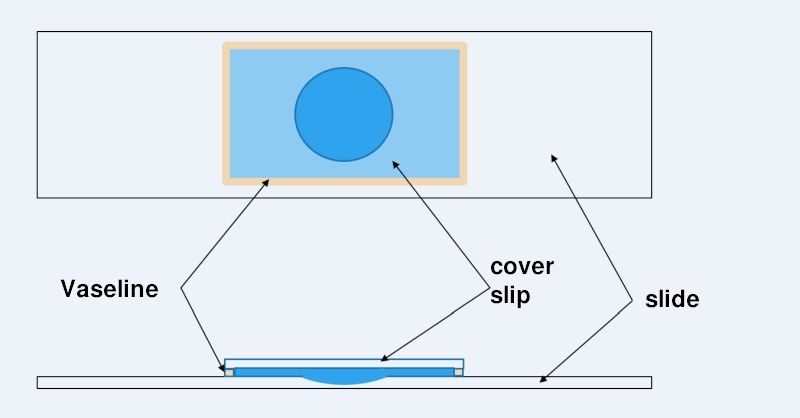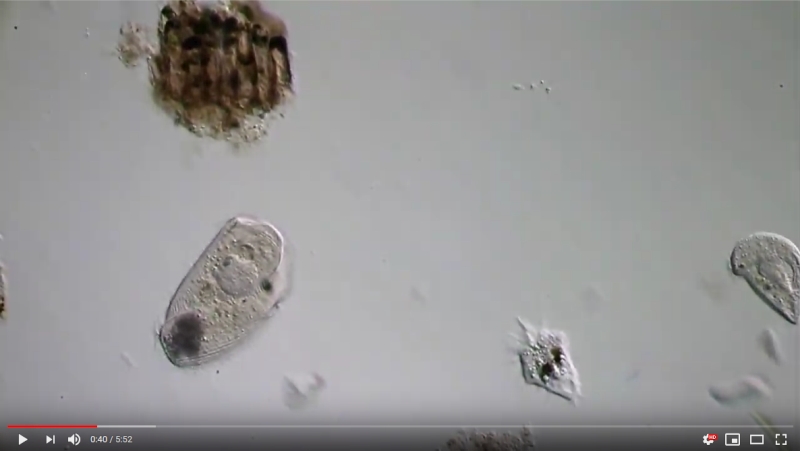Microaquarium
By microaquaria I mean slide-sized preparations that can be observed directly with a microscope. The optical quality of the microaquaria (especially the thickness of the slides) should be good enough to use any possible magnification. In addition, the life span of the organisms inside should be at least a few weeks to be able to study the behavior or development of the objects. Last but not least, the method must be easy and fast to use - a cumbersome method that requires a lot of equipment is not practical in my eyes in the amateur field.
A few years ago I came across a preparation method on the Internet, which I was able to develop into a long-term microaquarium. Such a microaquarium is constructed as follows:

Construction of a microaquarium
The life of a “normal” temporary wet preparation can be increased by effectively preventing the water from evaporating. This can be accomplished by sealing the cover glass with a Vaseline rim to make it watertight. Vaseline has a number of ideal properties for this purpose:
- it is absolutely waterproof
- Vaseline is permeable to air (known from Vaseline-based moisturizers)
- Vaseline is easy to apply due to its consistency
- it can be found inexpensively in every drugstore
To apply a Vaseline edge to the coverslip, apply a thin (!) film of Vaseline to the heel of your hand and wipe a thin ridge off the skin with each coverslip edge. The coverslip can then be placed directly on the slide (with specimen) with one edge. From this edge, lower the coverslip and slowly press the coverslip to the desired thickness using a wooden stick. Excess water is thus pressed out from under the coverslip and can then be easily removed.
To create a long-lasting microaquarium, it is necessary to include a relatively large amount of water in the preparation. If this water buffer is too small, the organisms would die after a few days. Therefore, a microscope slide with a hollow section is used for a microaquarium. To increase the area that can be used for observation, I use a coverslip that is as large as possible (e.g. 24mm x 32 mm or 24mm x 60mm). This maximizes the area outside the hollow grounded section - the area with the optimal slice thickness.
A microaquarium created this way has many advantages:
- Lifespan of organisms up to 6 weeks
- great mechanical stability:
- cleaning is easy due to the fixed cover glass
- vertical storage in normal preparation boxes (transparent cover!)
- absolutely stable conditions also for long-term video recordings
- Use of immersion oil is unproblematic: cover does not slip, oil does not penetrate under the cover glass
- additional effort for preparation only a few hand movements
But the main advantage in my eyes is that the organisms behave “naturally” after an acclimatization period of about one day in the micro aquaria. The typical great restlessness known from the “normal” temporary wet preparations has subsided and the enclosed animals go about their “daily business”. Most ciliates calmly graze their food or even stand in the same spot for hours, swirling their food in a relaxed manner. Gastrotrichs calm down and emerge from their hiding places after some time and graze - optimally observable - the underside of the cover glass.
To demonstrate these relaxed conditions in a microaquarium, I would like to show the following - almost unedited film - taken in several microaquariums a few days after their creation:

Please click on the picture to start the movie!
For me this kind of preparation is meanwhile the most satisfying way to observe the wonder world in the pond. Of course it is not possible to show the last anatomical details of the organisms. But you get the possibility to observe the behavior or the development of the organisms over a long period of time and without stress.